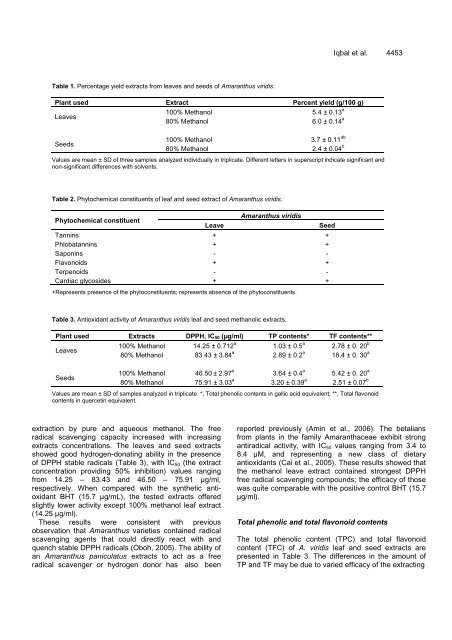Download Complete Issue (4740kb) - Academic Journals
Download Complete Issue (4740kb) - Academic Journals
Download Complete Issue (4740kb) - Academic Journals
You also want an ePaper? Increase the reach of your titles
YUMPU automatically turns print PDFs into web optimized ePapers that Google loves.
Table 1. Percentage yield extracts from leaves and seeds of Amaranthus viridis.<br />
Plant used Extract Percent yield (g/100 g)<br />
Leaves<br />
100% Methanol 5.4 ± 0.13 a<br />
80% Methanol 6.0 ± 0.14 a<br />
Seeds<br />
100% Methanol 3.7 ± 0.11 ab<br />
80% Methanol 2.4 ± 0.04 b<br />
Iqbal et al. 4453<br />
Values are mean ± SD of three samples analyzed individually in triplicate. Different letters in superscript indicate significant and<br />
non-significant differences with solvents.<br />
Table 2. Phytochemical constituents of leaf and seed extract of Amaranthus viridis.<br />
Phytochemical constituent<br />
Amaranthus viridis<br />
Leave Seed<br />
Tannins + +<br />
Phlobatannins + +<br />
Saponins - -<br />
Flavonoids + +<br />
Terpenoids - -<br />
Cardiac glycosides + +<br />
+Represents presence of the phytoconstituents; represents absence of the phytoconstituents.<br />
Table 3. Antioxidant activity of Amaranthus viridis leaf and seed methanolic extracts.<br />
Plant used Extracts DPPH, IC50 (µg/ml) TP contents* TF contents**<br />
Leaves<br />
100% Methanol 14.25 ± 0.712 a 1.03 ± 0.5 a 2.78 ± 0. 20 b<br />
80% Methanol 83.43 ± 3.84 a 2.89 ± 0.2 a 18.4 ± 0. 30 a<br />
Seeds<br />
100% Methanol 46.50 ± 2.97 a 3.64 ± 0.4 a 5.42 ± 0. 20 a<br />
80% Methanol 75.91 ± 3.03 a 3.20 ± 0.39 a 2.51 ± 0.07 b<br />
Values are mean ± SD of samples analyzed in triplicate. *, Total phenolic contents in gallic acid equivalent; **, Total flavonoid<br />
contents in quercetin equivalent.<br />
extraction by pure and aqueous methanol. The free<br />
radical scavenging capacity increased with increasing<br />
extracts concentrations. The leaves and seed extracts<br />
showed good hydrogen-donating ability in the presence<br />
of DPPH stable radicals (Table 3), with IC50 (the extract<br />
concentration providing 50% inhibition) values ranging<br />
from 14.25 – 83.43 and 46.50 – 75.91 µg/ml,<br />
respectively. When compared with the synthetic antioxidant<br />
BHT (15.7 µg/mL), the tested extracts offered<br />
slightly lower activity except 100% methanol leaf extract<br />
(14.25 µg/ml).<br />
These results were consistent with previous<br />
observation that Amaranthus varieties contained radical<br />
scavenging agents that could directly react with and<br />
quench stable DPPH radicals (Oboh, 2005). The ability of<br />
an Amaranthus paniculatus extracts to act as a free<br />
radical scavenger or hydrogen donor has also been<br />
reported previously (Amin et al., 2006). The betalians<br />
from plants in the family Amaranthaceae exhibit strong<br />
antiradical activity, with IC50 values ranging from 3.4 to<br />
8.4 µM, and representing a new class of dietary<br />
antioxidants (Cai et al., 2005). These results showed that<br />
the methanol leave extract contained strongest DPPH<br />
free radical scavenging compounds; the efficacy of those<br />
was quite comparable with the positive control BHT (15.7<br />
µg/ml).<br />
Total phenolic and total flavonoid contents<br />
The total phenolic content (TPC) and total flavonoid<br />
content (TFC) of A. viridis leaf and seed extracts are<br />
presented in Table 3. The differences in the amount of<br />
TP and TF may be due to varied efficacy of the extracting

















